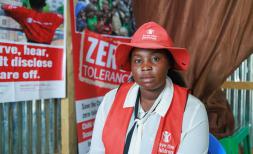Coronavirus Crisis Highlights Need for Child Benefits Globally

Children's survival, safety and protection and support for family finances are key pillars of Save the Children's Agenda for Action to #ProtectAGeneration throughout the coronavirus pandemic.
Never has there been a greater need globally for us all to get behind Child Benefits – here's why.
Save the Children stands with children everywhere – and their right to survive, learn and be protected. In these unprecedented times – when we are all being affected personally, professionally and financially – we need to think hard about how we maintain children's most basic rights. Parents and carers all over the world are struggling to meet their children's most basic needs. The World Food Programme (WFP) has warned that globally the number of people suffering from acute food insecurity – to which children are particularly vulnerable – could double to 265 million [1].
In Afghanistan, due to food price inflation and disruptions to informal sector jobs, families are struggling to afford sufficient nutritious food. In countries as diverse as Vietnam and Ghana, immunisation programmes have been disrupted by the COVID-19 response – denying children access to life-saving basic health services [2]. In conflict zones like Yemen and Syria – the virus is exacerbating already dire humanitarian situations. Children themselves are telling us how much they are worried – in Bangladesh, for example, vulnerable children reported to us that family income has stopped and they are going hungry.
Save the Children is closely tracking the impact of the pandemic on children – through a Live Impact Tracker. Unfortunately, the data is already showing worrying trends. The virus is not a 'great leveller' – it is highlighting the enormous inequalities in our societies across the world – including gender inequalities:
- With economic impacts hitting most countries in the world, we estimate that up to 30 million more children may fall into extreme poverty in Africa alone
- Evidence suggests that time out of school will exacerbate inequalities – a major blow for over 300 million children who normally depend on free school meals, and others who lack access to technology and other support for home learning
- Girls and women continue to face major challenges at home and work – with a higher burden of care, lower paid and more insecure work, and higher risk of violence in the home (including the "shadow pandemic" of gender-based violence). The pandemic could cause an additional 13 million child marriages, abruptly ending childhood for many girls
Save the Children is responding to this crisis at a scale never known before – from Italy, Spain, the US and UK to Bangladesh, Yemen, Somalia and Peru. A clear common theme everywhere, as the financial impacts of the pandemic become clear, is the need for high impact investments in children.
One solution with a solid track record, adopted in over 20 countries, is universal child benefits [3]. This idea is far from new – the Convention on the Rights of the Child and the Sustainable Development Goals both mention the need for 'social protection' for children. The reason for focusing on child benefits in particular is clear. There is solid evidence that cash transfers to families, particularly if linked to other services, can:
- Help reduce child mortality – this means fewer children dying from preventable causes
- Prevent chronic malnutrition – when provided during infancy, and combined with simple complementary interventions, such as information sessions on child health
- Increase access to education – enabling children, especially adolescent girls, to complete their education
- Reduce various forms of harm to children – including early marriage and child labour – and even reducing levels of violence at home
There are lots of other benefits too – particularly for systems that reach every child. Where schemes exist, children are more likely to be registered at birth and reached by essential services. For families that receive electronic transfers, they can simultaneously be linked to a bank account for savings and other services. There is a strong economic case for investing in children too. Grants can help caregivers – often women – invest in their own livelihoods reducing the need for grants in the longer term [4]. Investments in preventing child malnutrition are estimated to yield returns of US$16 for every US$1 spent [5].
Save the Children has been a pioneer of maternal and child grants, starting with the earliest years of life when children can be at their most vulnerable, in contexts as diverse as Nigeria and Myanmar [6]. We are working with many governments to support them in developing the programmes and systems – and we want to support them in many more.
To have the highest impact, schemes need to be carefully designed for the context - to ensure they are inclusive (including for children with disabilities), gender-sensitive and shock responsive. They should be able to scale up when other crises hit - including those linked to the climate crisis.
Systems take a while to be established, and the coronavirus economic impacts are happening right now. That's why we are calling for a rapid scale up in existing national systems to ensure more children and caregivers can access income support, and for humanitarian cash transfers, where governments are not in a position to reach those most in need.
Studies show Universal Child Benefits are within the financial means of many countries. However, we recognise that for some countries, even with the debt relief we are calling for, they would not be able to afford these measures at once. Some countries may need to start with a narrower focus – starting with the most deprived and marginalised populations groups, and maybe focusing on the first thousand days of a child's life when they are most vulnerable to malnutrition [7]. However, we are keen to see more countries taking steps along the path to more universal coverage so no child is left behind – and helping to break the intergenerational cycle of extreme poverty. For countries needing financial support to take these steps, we are joining others to call for a Global Fund to be established to support such schemes where governments struggle to afford them.
With the COVID-19 crisis putting children's rights at risk there has never been a better opportunity to get behind cash transfers to families in need. Each country, context and of course child is unique – but child benefits are a solution that warrants serious consideration by each and every government of the world.
All over the world, Save the Children is rapidly adapting our existing work whilst preparing for outbreaks of coronavirus in countries with limited capacity to respond. Read more about our response.
_____________________________
[2] Lancet
[3] https://www.unicef.org/social-policy/universal-child-grants
[4] World Bank
[6] In a survey conducted by SC in April 2020, 121 respondents between 12-18 with parents working as day labourers, petty traders, responded that family income had either completely stopped or was significantly reduced (96%). 64% said that the household was in serious food crisis.
[7] Tasker, M. and Harman, L. (2020) Investing in Early Years: The importance of protecting children through comprehensive social protection during the critical first 1,000 days of life. Global Social Policy, Vol 20(1), pp.21-25.







